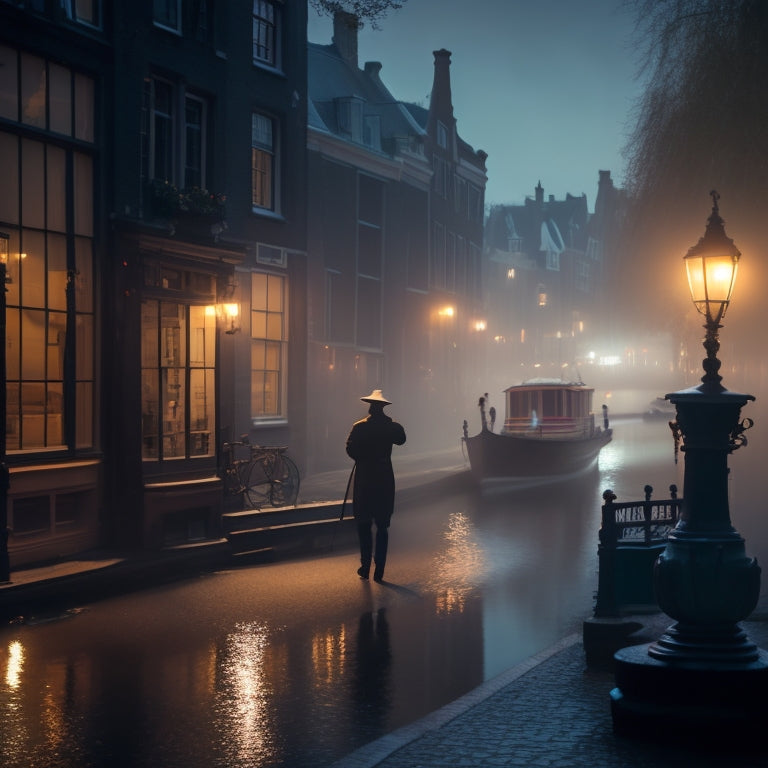
Saxophone Composition Unveils Amsterdam's Dark Charms
Share
This saxophone composition, premiered in 1995, masterfully captures the contrasting facets of Amsterdam's character, juxtaposing the city's whimsical charm with its darker, seedier aspects. Inspired by the nostalgic sounds of an old barrel-organ, the piece presents a nuanced portrayal of the city's essence. With its emotional resonance and technical complexity, the composition has garnered critical acclaim and enduring appeal. As we explore the intricacies of this sonic portrait, the city's hidden narratives and contradictions come to life, beckoning us to uncover more of its secrets.
Key Takeaways
• The saxophone composition, premiered in 1995, is inspired by the nostalgic sounds of an old barrel-organ in Amsterdam.
• The piece portrays Amsterdam's charming facade and darker aspects, showcasing the conflict and dichotomy in the city's nature.
• The composition has received positive reception from audiences and performers, praised for its emotional resonance and technical complexity.
• The sheet music is available for saxophonists, published by June Emerson Wind Music, and includes parts for Eb and Bb saxophones with piano accompaniment.
• Composer Nigel Wood's insights reveal the intricate layering of sounds, capturing Amsterdam's charm and darker undertones, making the composition a unique and captivating work.
Composition Background and Inspiration
Originally written for the Saxophonia saxophone choir, this evocative composition premiered at their debut concert in April 1995, drawing inspiration from the nostalgic sounds of an old barrel-organ in Amsterdam. The composer's fascination with the barrel organ sounds led to a nuanced portrayal of conflict, juxtaposing the city's charming façade with its darker, seedier aspects.
This dichotomy is expertly woven throughout the composition, showcasing the composer's skill in capturing the essence of Amsterdam's contradictory nature. The result is a rich, evocative piece that deftly balances charm and sleaze, inviting listeners to experience the city's multifaceted personality.
Performance and Critical Acclaim
The 2007 Saxophone Prize at Birmingham Conservatoire featured this composition as a set piece, propelling it into the spotlight and earning it a succession of performances that showcased its versatility and depth.
The performance reception was overwhelmingly positive, with audiences and performers alike praising the work's emotional resonance and technical complexity. As a result, the composition has enjoyed a sustained period of recognition, with numerous performances and accolades solidifying its place in the saxophone repertoire.
Audience feedback has been instrumental in shaping our understanding of the piece, offering valuable insights into its emotional impact and technical demands. Through its performance history, the composition has demonstrated an enduring appeal, enthralling listeners and inspiring performers with its unique blend of charm and darkness.
Sheet Music and Composer Insights
As the composition's popularity continued to grow, its availability in sheet music form became a natural next step, allowing saxophonists to explore the intricate melodies and harmonies that evoke Amsterdam's contrasting atmospheres.
Published by June Emerson Wind Music, the sheet music is available in PDF E-Edition for £13.99, inclusive of parts for Eb and Bb saxophones, accompanied by piano parts. The E-Edition bundle also features an MP3 play-along piano accompaniment, providing a detailed resource for performers.
Composer Nigel Wood, renowned for his contributions to saxophone music, shares insights into his creative process through composer interviews, offering a deeper understanding of the composition's nuances. Musical analysis reveals the intricate layering of sounds, expertly capturing the essence of Amsterdam's charm and darker undertones.
Frequently Asked Questions
How Does the Saxophone Convey the Contrast Between Charm and Sleaziness?
Through tonal nuance, the saxophone masterfully conveys the contrast between charm and sleaziness, leveraging sonic duality to juxtapose bright, airy phrases with darker, sultry undertones, expertly capturing the complex essence of Amsterdam's dual nature.
What Inspired the Composer's Use of Barrel-Organ Sounds in the Piece?
The composer's use of barrel-organ sounds was inspired by the nostalgic allure of mechanical nostalgia, evoking Carnival echoes that juxtapose innocence with seediness, capturing the essence of Amsterdam's dual nature.
Can This Composition Be Played by Saxophonists of All Skill Levels?
'Crafting complexity with care, Nigel Wood's composition presents technical challenges, yet maintains musical accessibility, making it suitable for saxophonists of varying skill levels, who can decipher its nuances and reveal its dark, charming essence.'
Are There Any Specific Performance Techniques Required to Capture the Atmosphere?
To capture the atmosphere, saxophonists should employ subtle vocal inflections and breathy tones, evoking the haunting, nostalgic quality of Amsterdam's old barrel-organ sounds, thereby conveying the city's intricate balance of charm and sleaziness.
How Does the Piano Accompaniment Enhance the Overall Mood of the Piece?
'Music is the divine way to tell a story.' The piano accompaniment in this piece masterfully enhances the mood by providing harmonic depth, nuanced dynamic shifts, and subtle rhythmic oscillations, which elegantly underscore the saxophone's melodic contours, conjuring a mesmerizing atmosphere of contrasts.
Related Posts
-

Dance Wear Must-Haves for Elevated Performance
To raise your dance performance, prioritize wear that offers superior breathability and comfort. Look for moisture-wi...
-

What Are the Essential Performance Clothing Items for Your Next Workout
When it comes to crushing your next workout, the right performance clothing can make all the difference. You'll want ...
-

Tutu Fun: Ballet Scrunchie Cards Dance Delight
Ballet enthusiasts can elevate their dance style with unique digital downloads, specifically designed ballet-inspired...


